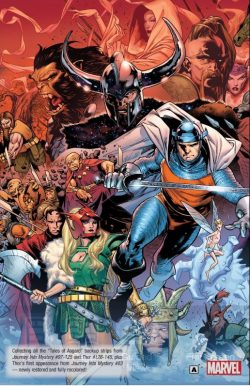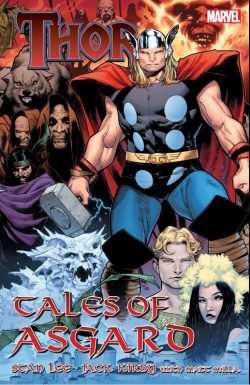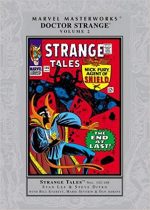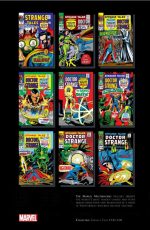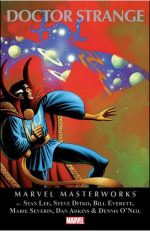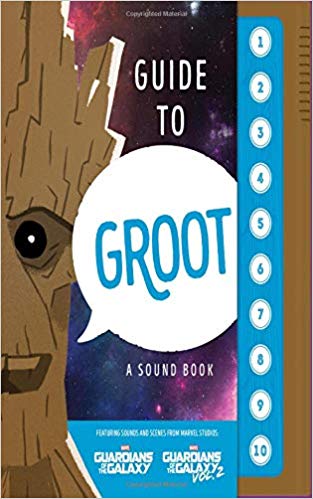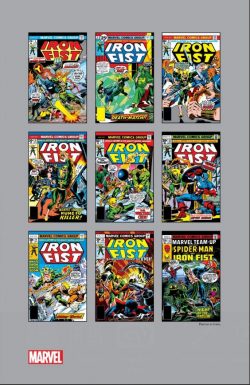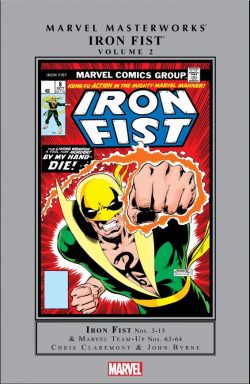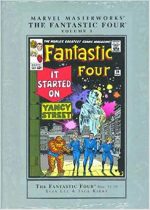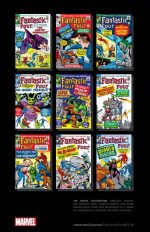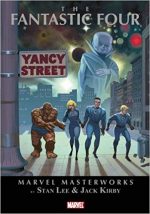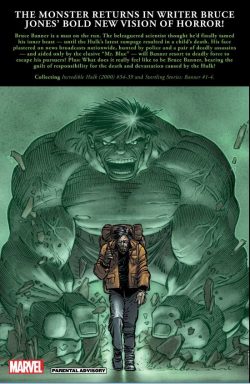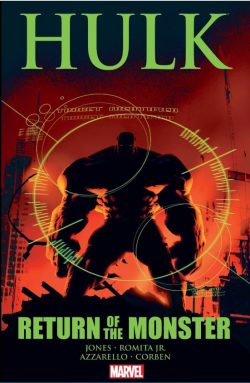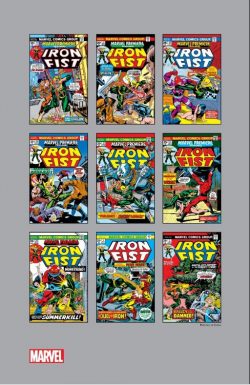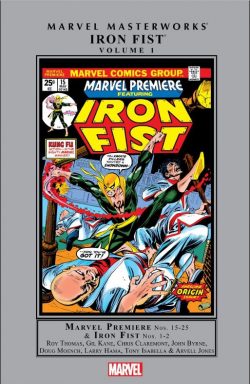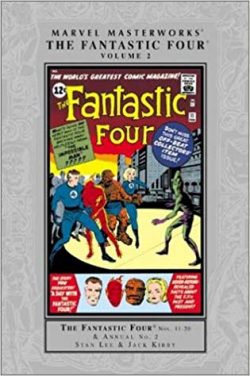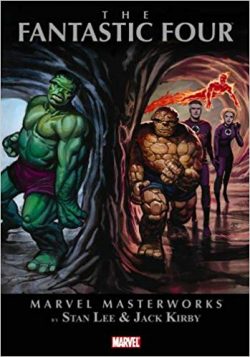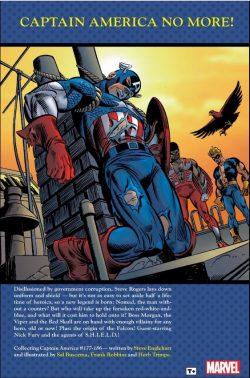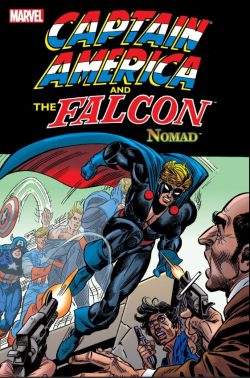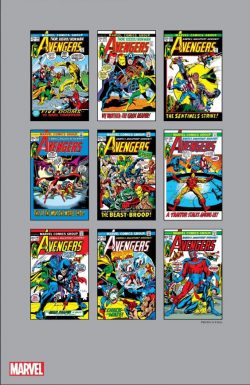
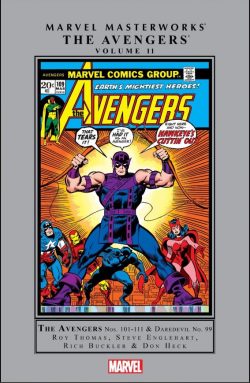
By Roy Thomas, Steve Englehart, Harlan Ellison, Chris Claremont, Stan Lee, Steve Gerber, Rich Buckler, Don Heck, John Buscema, George Tuska, Jim Starlin, Dave Cockrum, Sam Kweskin & various (Marvel)
ISBN: 978-0-7851-5038-1 (HB)
Win’s Christmas Gift Recommendation: Pure Blockbuster Entertainment… 8/10
One of the most momentous events in Marvel Comics history occurred in 1963 when a disparate array of individual heroes banded together to stop the Incredible Hulk.
The Avengers combined most of the company’s fledgling superhero line in one bright, shiny and highly commercial package. Over the decades the roster has unceasingly changed, and now almost every character in their universe has at some time numbered amongst their colourful ranks…
The Avengers always proved that putting all one’s star eggs in on single basket paid off big-time; even when all Marvel’s all-stars such as Thor, Captain America and Iron Man were absent, it merely allowed the lesser lights of the team to shine more brightly.
Of course, all the founding stars regularly featured due to a rotating, open door policy which meant that most issues included one of any reader’s favourites. The increasingly bold and impressively ambitious stories and artwork were no hindrance either even though at this particular time, creators were passing through at an even faster rate than the masked marvels…
Graced with a scene-setting Preface from outgoing scripter Roy Thomas and context-creating Introduction from new kid Steve Englehart, this sturdy hardcover and eBook compilation gathers the astounding contents of Avengers #89-100 (collectively spanning July 1972 – May 1973) and includes a cross-over moment from Daredevil and the Black Widow #99.
Now scripter extraordinaire Thomas was about to hand over the reins to an even more imaginative and groundbreaking author who took the team to dizzying new imaginative and dramatic heights, but before that he and debuting penciller Rich Buckler – doing his best Neal Adams impersonation – shone on a Harlan Ellison tale inked by Dan Adkins.
‘Five Dooms to Save Tomorrow!’ was based on an Ellison novella from 1964 and found the Avengers battling Leonard Tippit, an ordinary man granted incredible power so that he could murder five innocent human beings. To be fair though, those innocuous targets’ continued existence threatened Earth’s entire future…
Determined to stop him whatever the ultimate consequences, the Avengers eschewed the murky moral quandary and were tested to their utmost, before the crisis was averted…
The heroes were on firmer, more familiar ground in #102 when the Grim Reaper returned, offering to place the Vision’s consciousness in a human body in return for the android’s allegiance in ‘What to Do Till the Sentinels Come!’ (Thomas, Buckler & Joe Sinnott). Meanwhile, the mutant-hunting robots kidnapped the Scarlet Witch and started another scheme to eradicate the threat of Homo Superior forever…
A budding romance between the Witch and the Vision revealed tensions and bigotries in the most unexpected places as the cataclysmic tale continued with ‘The Sentinels are Alive and Well!’ as the team search the globe for the monstrous mechanical marauders before being captured themselves whilst invading their Australian Outback hive.
The tale concludes ‘With a Bang… and a Whimper!’ as the assembled heroes thwart the robots’ project to sterilise humanity – but only at the cost of two heroes’ lives…
The grieving Scarlet Witch takes centre stage in #105 as ‘In the Beginning was… the World Within!’ (by new scripter Steve Englehart and veteran artists John Buscema & Jim Mooney) as the team travel to South America and encounter cavemen mutants from the lost world known as the Savage Land, after which the Avengers discover ‘A Traitor Stalks Among Us!’ (illustrated by Buckler, George Tuska & Dave Cockrum) with the revelation that perennial sidekick Rick Jones has become atomically bonded to alien hero Captain Marvel: a revelation that triggers a painful flashback in memory-blocked Captain America, and just as an old foe turns the team against itself.
Avengers #107 reveals ‘The Master Plan of the Space Phantom!’ (with art by Jim Starlin, Tuska & Cockrum) and his complex and sinister alliance with the Grim Reaper even as the love-sick Vision finally accepts the Faustian offer of a human body.
Unfortunately, the corpus on offer is the Star-Spangled Avenger’s…
‘Check… and Mate!’ – illustrated by veteran Avenger artist Don Heck and inkers Cockrum & Sinnott – wraps up the intriguing saga in spectacular fashion as an army of Avengers thrash Phantom, Reaper and assorted hordes of Hydra hoods. However, the true climax is the Vision and Witch’s final acknowledgement of their love for each other.
The announcement provokes a storm of trouble…
In #109 Hawkeye, who’s always carried a torch for the beautiful Wanda, quits the team in a dudgeon and ‘The Measure of a Man!’ (Heck & Frank McLaughlin) find the heartsick archer duped by billionaire businessman Champion and almost responsible for causing the complete destruction of California before wising up and saving the day…
Next the depleted team of Captain America, Thor, Iron Man, Scarlet Witch, Vision and Black Panther investigate the disappearance of mutant heroes the X-Men and are thoroughly beaten by an old enemy with a new power.
‘… And Now Magneto!’ (Englehart, Heck, Frank Giacoia & Mike Esposito) ends with half the team brainwashed captives of the master villain with the remaining crusaders desperately searching for new allies. We then pop over to San Francisco and a crossover from Daredevil and the Black Widow #99 (May 1973, by Steve Gerber, Sam Kweskin & Syd Shores). ‘The Mark of Hawkeye!’ sees Natasha Romanoff‘s old boyfriend fetch up on the Widow’s doorstep, determined to reclaim her. The caveman stunt culminates in the Archer’s sound and well-deserved thrashing, and when the last Avengers arrive, asking him to return and assist, he refuses. DD and the Widow don’t, though…
The saga resumes and concludes in Avengers #111 as, ‘With Two Beside Them!’ (Englehart, Heck & Esposito) the returned heroes and West Coast vigilantes successfully rescue the X-Men and Avengers enslaved by the malevolent Magneto. With the action over, Daredevil returns to California but the Black Widow elects to stay with the World’s Mightiest Heroes…
This titanic tome also offers extra treats: namely an unused page of Buckler’s beautiful pencil art and his Sinnott-inked cover for Avengers #104.
Roy Thomas and his artistic collaborators were always at the forefront of Marvel’s second generation of creators: brilliantly building on and consolidating Lee, Kirby and Ditko’s initial burst of comics creativity whilst spearheading and constructing a logical, fully functioning wonder- machine of places and events that so many others could add to.
These terrific tales are ideal examples of superheroes done exactly right and also act as pivotal points as the underdog company evolved into a corporate entertainment colossus. There are also some of the best superhero stories you’ll ever read and Englehart’s forthcoming concoctions would turn the Marvel Universe on its head and pave the way for a new peak of cosmic adventure…
© 1972, 1973, 2016 Marvel Characters, Inc. All rights reserved.

